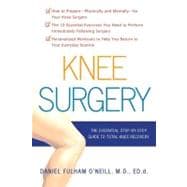
What is included with this book?
Daniel Fulham O’Neill, M.D., Ed.D. is in private practice in New Hampshire with The Alpine Clinic, and for over twenty years, has been caring for knees of all activity levels, from professional athletes to people who just want to walk the dog without pain. When not caring for his patients, he can be found riding his bike, hiking, and skiing in the White Mountains.
| List of Illustrations | p. xi |
| Acknowledgments | p. xiii |
| Introduction | p. 1 |
| Journey into Surgery | |
| The Road to Knee Surgery: The Anatomy and Pathology You Need to Know Before Starting Your Journey | p. 7 |
| Getting Your Knee Ready for Surgery: Decreasing Inflammation plus Eight Range-of-Motion Stretches for Before and After Surgery | p. 19 |
| Ten Essential Exercises for Before and After Surgery: Prong 1 of the Three-Pronged Attack | p. 39 |
| Getting Your Life Ready for Surgery: Pre-op Checklists and Tips-Sweating the Small Stuff | p. 59 |
| The Surgery Itself: What to Expect | p. 71 |
| The Knee Doctor's After-Surgery Program | |
| The Critical First Week: Prong 2 of the Three-Pronged Attack: Movement Patterns for Your Return to Life | p. 79 |
| Understanding Muscles: Negative Talk, and Breaking Through Roadblocks | p. 101 |
| Aerobic Training: Prong 3 of the Three-Pronged Attack | p. 111 |
| Testing the Waters: The Ultimate Soft Workout | p. 125 |
| Prong 1, Level B: Four New Exercises and Noise Reduction | p. 137 |
| Total Recovery and Beyond | |
| Prong 1, Level C: Six More Exercises for Life After Knee Surgery | p. 155 |
| Return to Sports and Competition: For the Athlete in All of Us | p. 171 |
| Frequently Asked Questions: Sunbathing, Supplements, Getting Back to Work, and More | p. 197 |
| Epilogue | p. 209 |
| Resources | p. 211 |
| Glossary | p. 219 |
| Table of Contents provided by Ingram. All Rights Reserved. |
The New copy of this book will include any supplemental materials advertised. Please check the title of the book to determine if it should include any access cards, study guides, lab manuals, CDs, etc.
The Used, Rental and eBook copies of this book are not guaranteed to include any supplemental materials. Typically, only the book itself is included. This is true even if the title states it includes any access cards, study guides, lab manuals, CDs, etc.